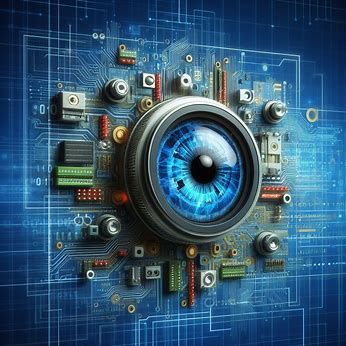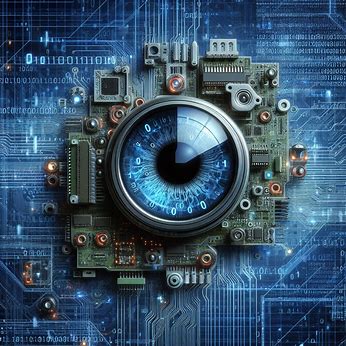Introduction of Computer Vision
Computer vision, an interdisciplinary field within artificial intelligence (AI), has fleetly evolved over the once many decades, transubstantiating the way machines perceive and interpret the visual world. From facial recognition in smartphones to independent vehicles navigating complex surroundings, computer vision technologies have come ubiquitous in our diurnal lives and colorful diligence. In this comprehensive disquisition, we claw deep into the complications of computer vision, its operations, challenges, recent advancements, and the unborn prospects it holds.
Comprehending Computer Vision
At its substance, computer vision aims to equip machines with the capability to prize meaningful information from visual data, mimicking the capabilities of the mortal visual system. This involves tasks similar as image bracket, object discovery, segmentation, stir analysis, and 3D reconstruction. Through sophisticated algorithms and ways, computer vision systems can dissect and interpret images or vids to make intelligent opinions and take applicable conduct.
Operations of Computer Vision
The operations of computer vision are vast and different, gauging across multitudinous disciplines including healthcare, automotive, retail, husbandry, manufacturing, surveillance, and entertainment. In healthcare, computer vision plays a vital part in medical imaging, aiding radiologists in diagnosing conditions fromX-rays, MRIs, and CT reviews. It enables early discovery of abnormalities, abetting in timely treatment and perfecting patient issues.
Also, computer vision is revolutionizing the automotive assiduity with the development of independent vehicles. By assaying real- time data from cameras, LiDAR, and other detectors, these vehicles can perceive their surroundings, descry obstacles, and navigate safely without mortal intervention. This technology holds the pledge of reducing road accidents and enhancing mobility for individualities worldwide.
'Another challenge is the reflection and labeling of large- scale datasets needed for training machine literacy models in computer vision. Homemade reflection can be time- consuming, precious, and prone to crimes, limiting the vacuity of high- quality labeled data. also, impulses in the data can lead to prejudiced prognostications and ethical enterprises, particularly in operations similar as facial recognition and surveillance.
likewise, icing the sequestration and security of visual data remains a critical challenge in computer vision. As the proliferation of cameras and detectors continues, enterprises regarding data breaches, unauthorized surveillance, and abuse of particular information have escalated. Addressing these challenges necessitates the development of robust encryption ways, sequestration- conserving algorithms, and transparent data governance fabrics.
Recent Advancements in Computer Vision
Recent times have witnessed significant advancements in computer vision, driven primarily by improvements in deep literacy and convolutional neural networks( CNNs). Deep literacy models have demonstrated remarkable performance in colorful computer vision tasks, surpassing mortal- position delicacy in tasks similar as image bracket and object discovery.
One of the crucial advancements in computer vision is the development of generative inimical networks( GANs) for image conflation and metamorphosis. GANs correspond of two neural networks – a creator and a discriminator – which are trained adversarially to induce realistic images. This technology has led to inventions in style transfer, image inpainting, andsuper-resolution, enabling the creation of high- quality visual content.
ALso, underpinning literacy has surfaced as a promising approach for interactive perception and decision- making in computer vision. By combining deep underpinning learning with computer vision, experimenters have developed systems able of learning to perceive and interact with their surroundings in real- time. These systems have operations in robotics, stoked reality, and mortal- computer commerce.
likewise, neural armature hunt( NAS) has gained traction as a system for automatically designing optimal infrastructures for deep literacy models in computer vision. NAS algorithms explore the space of possible infrastructures and identify configurations that achieve superior performance on specific tasks. This approach has led to the development of effective and scalable models that outperform handcrafted infrastructures.
Unborn Prospects of Computer Vision
Looking ahead, the future of computer vision is filled with instigative possibilities and openings for invention. Advancements in tackle, similar as neuromorphic computing and technical accelerators for deep literacy, will enable the development of more effective and important computer vision systems. also, the integration of multimodal data, including visual, textual, and detector data, will enrich the capabilities of computer vision models and enhance their interpretability.
likewise, the confluence of computer vision with other arising technologies, similar as stoked reality( AR), virtual reality( VR), and the Internet of effects( IoT), will unleash new operations and stoner gests . From immersive gaming and interactive liar to smart surveillance and intelligent assistive technologies, the emulsion of these technologies will reshape how we perceive and interact with the world around us.
also, addressing societal and ethical considerations will be consummate in shaping the future of computer vision. As these technologies come more pervasive, it's essential to insure translucency, fairness, and responsibility in their design, deployment, and operation. Ethical fabrics, nonsupervisory programs, and interdisciplinary collaborations will play a pivotal part in fostering responsible invention and mollifying implicit pitfalls and impulses.
Conclusion
In conclusion, computer vision represents a foundation of artificial intelligence, enabling machines to perceive, understand, and interact with the visual world in profound ways. From healthcare and automotive to retail and husbandry, computer vision technologies are driving invention and transubstantiating diligence across the globe.
While challenges persist, recent advancements and unborn prospects hold pledge for uninterrupted progress and impact in the times to come. As we embark on this trip of disquisition and invention, it's imperative to embrace ethical principles and unite across disciplines to harness the full eventuality of computer vision for the benefit of society.
RELATED POST....
radiation Protection technology
transportation technology on mars
Impact of Technology on Ancient Industries
the Environmental impact of E west
augmente reality in feild passage
nassa mission to touch the sun
important Rocket Set to Soar into the Cosmos
20 Instances of Digital Technology
wolrd fastest wooden satellite in 2024
Electric vehicles charging in 2024
Ultraloq Bolt and the Smart Lock
Unraveling the Apple Patent Dispute:
CineBeam Qube 4K UHD Projector
Twitter-X Elon Musk Content Moderation
tesla Cybertruck crash in palo alto


.jpeg)

.jpeg)



.jpeg)






.png)
0 Comments